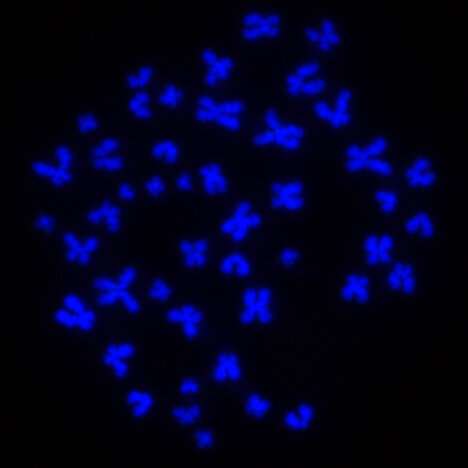Scientists develop technique to reveal epigenetic features of cells in the brain

The brain's prefrontal cortex, which gives us our ability to solve problems and plan ahead, contains billions of cells. But understanding the large diversity of cell types in this critical region, each with unique genetic and molecular properties, has been challenging.
Scientists have known that much of this diversity results from epigenetics (such as the chemical tags on DNA) as well as how epigenetic features ultimately fold up within chromosomes to affect how genes are expressed.
Now, Salk researchers have developed a method to simultaneously analyze how chromosomes, along with their epigenetic features, are compacted inside of single human brain cells. A collaborative team of scientists from the Ecker and Dixon labs combined two different analysis techniques into one method, which enabled them to identify gene regulatory elements in distinct cell types. The work, which was published in Nature Methods on September 9, 2019, paves the way toward a new understanding of how some cells become dysregulated to cause disease.
"We've taken this new and better approach to analyzing the genomes of single cells and applied it to healthy brain tissue," says Salk Professor and Howard Hughes Medical Institute Investigator Joseph Ecker, head of the Genomic Analysis Laboratory and the paper's co-corresponding author. "The next step is to compare normal and disease tissue."
How DNA is packed within structures called chromosomes in a cell's nucleus can play a critical role in cellular function. And how DNA is ultimately folded depends on which sections of DNA need to interact with each other and which need to be easily accessible to cellular machinery. The structure of chromosomes acts as a sort of cellular fingerprint: although different cell types have the same sequence of DNA, they have different chromosome structures to organize that DNA.
At the same time, chemical (epigenetic) modifications to DNA itself—such as the addition of methyl groups to a strand of DNA—also control the timing and levels of gene expression. When a methyl group is tacked onto a bit of DNA, a gene is typically blocked from being expressed.
In the past, researchers have had to use separate methods to determine chromosome structures and methylation patterns of individual cells. In July, for instance, Ecker's team reported they had developed a new tool that could differentiate cell types based solely on chromosome structure. And in 2017, they sorted mouse and human brain cells based on their methylation patterns.
When doing the experiments separately, however, researchers can't determine how chromosome structure and methylation patterns might be related. It has been unclear whether each subset of chromosome structures corresponds to a subset of methylation patterns. Or whether the two datasets, when combined, reveal more nuanced subtypes of cells.
In their new method, called single-nucleus methyl-3C sequencing (sn-m3C-seq), the Salk team "double dips" from each single cell, collecting data on both chromosome structure and methylation at the same time. While doing the process manually would be slow and cumbersome, the team automated sn-m3C-seq, letting them easily study thousands of cells. The development of new approaches to handle cells, coupled with new computational methods to handle data, enabled this new technique.
The team says developing a method that examines these features in single cells allows scientists to use certain "analytical tricks" to directly study tissue samples and resolve chromosome structure and DNA methylation in all the different cell types in the tissue. "We know these features can vary a lot between cell types and there's value in having both types of information together from the same cells," says Jesse Dixon, a Helmsley-Salk Fellow and co-corresponding author. "It really opens up our ability to understand what regulatory sequences are affecting which genes across a wide variety of cell types and tissues."
Knowing what regulatory sequences regulate which genes has important implications for understanding how genetic variations may contribute to human disease. For example, much of the genetic variation the contributes to common human brain diseases like schizophrenia and depression, as well as non-brain diseases like heart disease, lies in regions of our genome that are far away from genes. The researchers say that, by studying chromosome folding in actual human tissues and resolving distinct cell types, these methods may allow them to link disease-causing genetic variants with the genes they regulate, which may tell them more about why certain variants contribute to diseases and offer insights into how to best treat them.
To test out sn-m3C-seq, Ecker, Dixon and colleagues applied the method to more than 4,200 human brain prefrontal cortex cells. While using data from chromosome structure alone allowed only the crude separation of neurons from non-neurons, combining the approaches let the researchers identify gene regulatory elements in distinct cell types and then further study the chromosome structures present in each cell type.
Moreover, the team noticed relationships between the two levels of regulation that they plan to study more in the future. Now that the method is established, they'd like to begin applying it to more types of both healthy and diseased tissues.
Instrumental to that effort will be a four-million-dollar grant that Dixon and Ecker received from the National Institutes of Health's National Genome Research Institute on September 6, 2019, which will greatly facilitate their studies of gene regulation in human tissues and diseases such as cancer.
More information: Simultaneous profiling of 3D genome structure and DNA methylation in single human cells, Nature Methods (2019). DOI: 10.1038/s41592-019-0547-z , nature.com/articles/s41592-019-0547-z
Journal information: Nature Methods
Provided by Salk Institute





















